One of our favorite spots on our Pacific journey was Gerstle Cove, part of California’s Salt Point State Park. This area is located about 90 miles north of San Francisco. We timed it just right to visit at low tide, a must if you want to see tide pools. This was my boys’ first experience with tide pools, and it ranked at the top of their memories from the whole vacation.
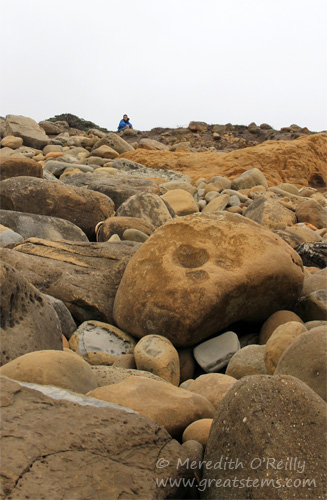
To get to the tide pools we climbed down large sandstone rocks just off the Salt Point trail. There is an easier location to get to, but this area came recommended by the park ranger since we weren’t limited by having small children in the group. The geologic processes in this area are worth a visit alone.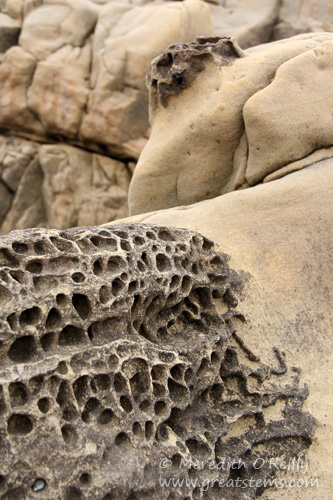 The landscape of Salt Point is formed primarily by two major processes. Plate tectonics are responsible for the terraces along the shore, while wave action creates coves, shapes rocks, and moves rocks or carries them away. Some of the rocks are sculpted into knobs, bowls, or ribs. Others display remarkable tafoni, honeycomb-like features created by biological, chemical, and physical weathering.
The landscape of Salt Point is formed primarily by two major processes. Plate tectonics are responsible for the terraces along the shore, while wave action creates coves, shapes rocks, and moves rocks or carries them away. Some of the rocks are sculpted into knobs, bowls, or ribs. Others display remarkable tafoni, honeycomb-like features created by biological, chemical, and physical weathering.
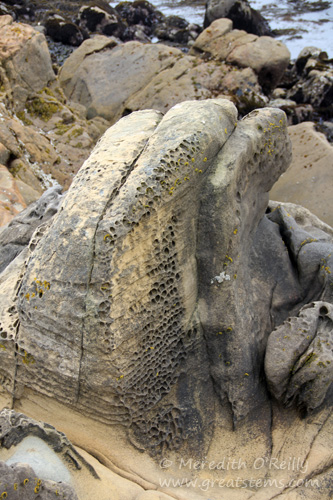
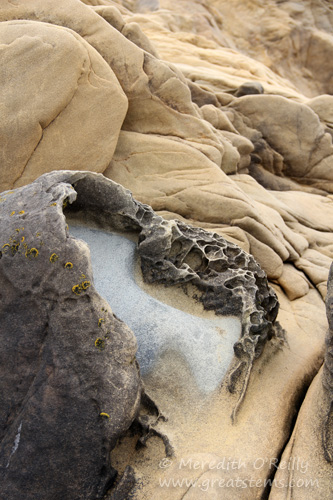
Some of the patterns were works of art in themselves.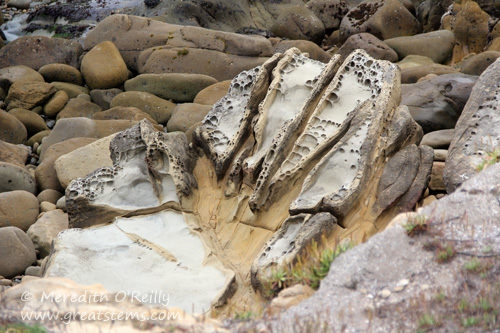
Coming down from the rocks, we first entered the splash zone, the area just above the intertidal zones. At this level, water splashes on the rocks above the average high-tide height.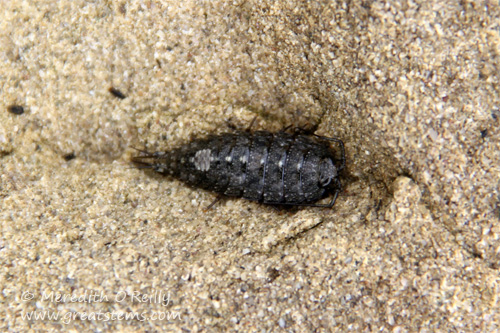
In the splash zone, we began to see the first marine life, including this rock louse. A rock louse is considered nearly terrestrial — while it can be found on land, it stays close to the water to keep its gills moist. The rock louse is related to the pill bug, both being isopod crustaceans.
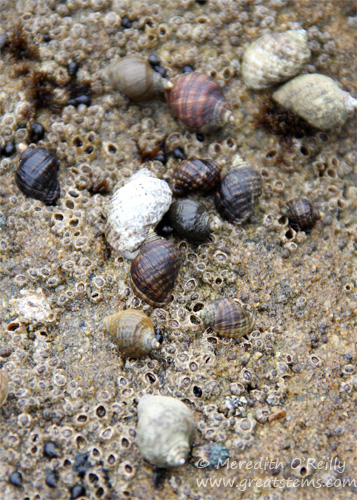
Acorn barnacles and periwinkles are other common sights in the splash zone. Acorn barnacles are sessile, growing their shell directly — and permanently — on a rock or other hard substrate. Periwinkles, small sea snails, also can temporarily cement themselves to the rocks with a hardened mucus. This allows them to survive out of the water for a long period of time, but when the conditions are right, they can move on at will.
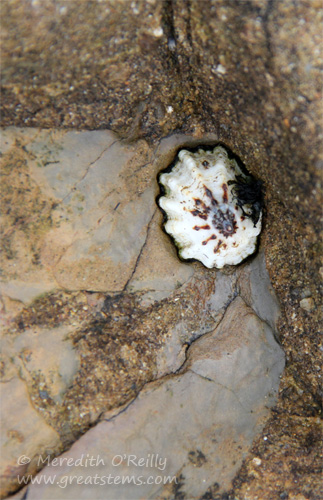
This is a rough limpet, nestled in a “home site” it has grooved out of the rock. It’s a tight, custom fit — this helps protect it from predators and from desiccation. Limpets are specially adapted for clinging to rocks, having a low broad shell and a mucus-covered foot that functions as an adhesive organ, as well as for movement. When the rocks are wet, the limpet will move about for feeding, then it will return to its home site for low tide.
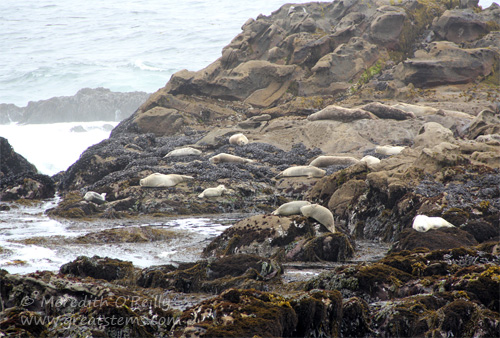
Just below the splash zone is the high intertidal zone, an area that gets submerged only during high tide. Here algae, such as sea lettuce and rockweed, as well as stranded bits of kelp, covered the rocks, making the surfaces quite slick and very hazardous to traverse — one slip and bones will break. With the slippery rocks and water still flowing and splashing very close to us, it was quite clear why small children would be at risk in this setting.
Believe it or not, we were so focused on the tide pools (lower area of the photo above), looking for small marine life and making sure not to slip, that it was several minutes before we realized that a large group of harbor seals was hauled out and resting on the exposed rock ahead of us.
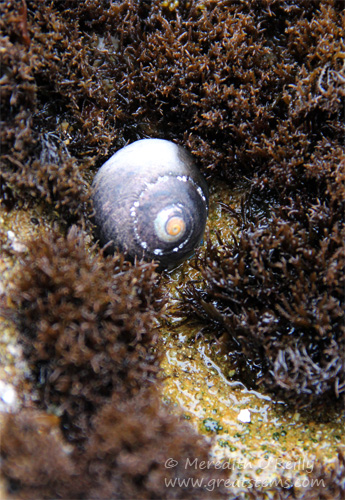
Black turban snails are plentiful at Gerstle Cove, and they are easily found in the high intertidal zone. They eat macroscopic algae, kelp, and diatoms, and they are prepared to drop away quickly if a sea star or sea otter attempts to capture them. Empty black turban snail shells are a great example of recycling in nature — we saw many a hermit crab wearing the shells for a home.
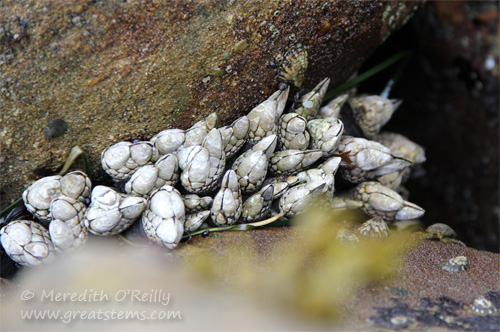
These are gooseneck barnacles, which attach to rocks with a strong, rubbery stalk; this is different from the attachment method of the sessile acorn barnacles. The gooseneck barnacles are adapted to trap food as moving water brings it by.
Note: we also visited tide pools near the visitor center. At this point I’m going to mix the photos deliberately to talk about the wildlife we spotted.
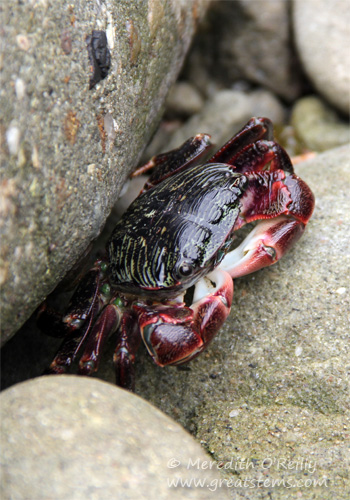
Hanging out in both the high and mid intertidal zones are crabs, and lots of them. We saw mostly striped shore crabs, though they did their best to scurry into hiding spots if they saw us.
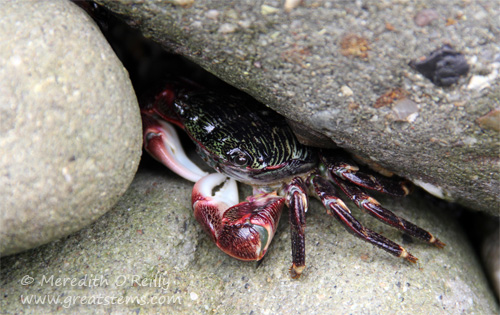
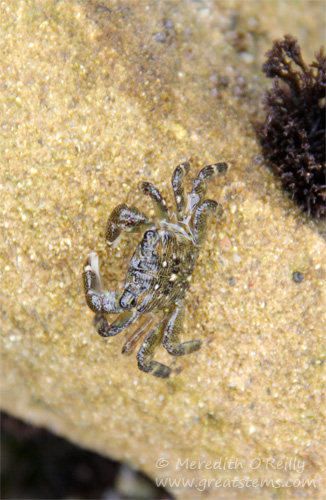
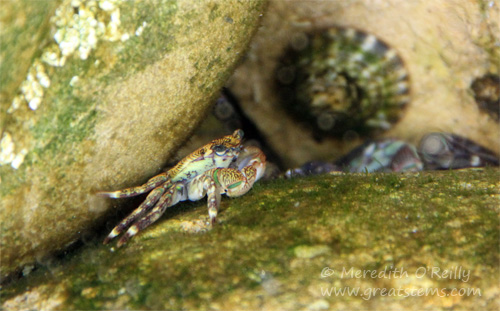
Though some striped shore crabs were purple in coloration and others tan or green, those transverse lines across the carapace were always the key to identification.
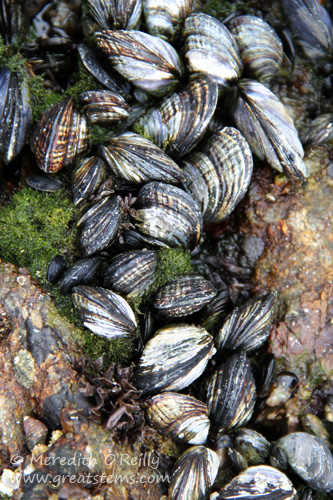
California mussels depend on the moisture present in the mid intertidal zone. They adhere to rocks and to each other, forming large aggregations, often out-competing other animals for space on rocks. However, this clustering forms a habitat in itself, and many species of wildlife live on or among the mussels.
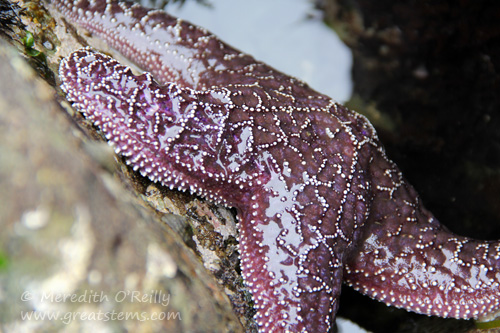
An important predator of the California mussel is the ochre sea star, this one purple. The ochre sea star is considered a keystone species because of the critical role it plays in controlling the populations of mussels. The loss of only a few ochre sea stars can have a tremendous impact on the number of mussels in an area, affecting the overall health of the intertidal environment.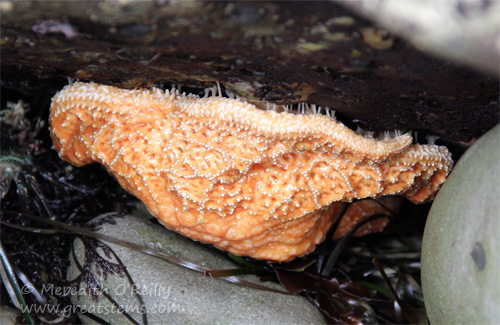
This is an orange ochre sea star. See the tube feet helping it adhere and move on the rock? These same tube feet help a sea star open mussels and handle other prey.
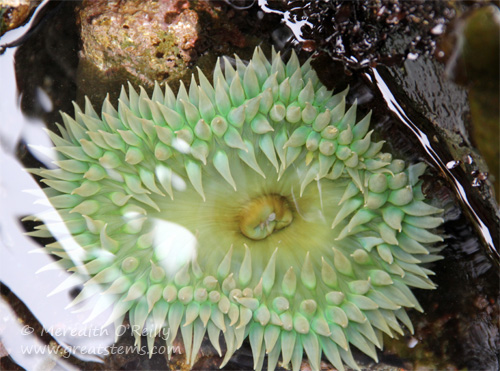 The giant green anemone, Anthopleura xanthogrammica, has a green oral disk, with only faint radiating lines, and green tentacles. As its name implies, this anemone can get quite big. While often found alone, it will sometimes be seen in a group with other anemones without aggravation.
The giant green anemone, Anthopleura xanthogrammica, has a green oral disk, with only faint radiating lines, and green tentacles. As its name implies, this anemone can get quite big. While often found alone, it will sometimes be seen in a group with other anemones without aggravation.
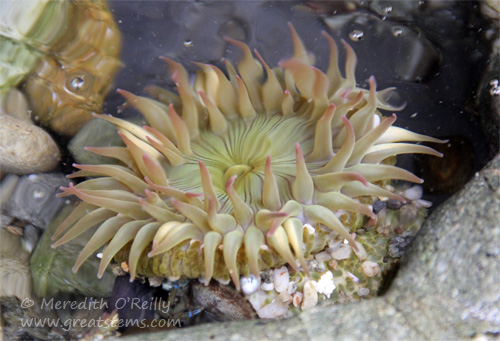 In contrast, a sunburst anemone, Anthopleura sola, is a solitary anemone with distinct radiating lines and pink-tipped tentacles.
In contrast, a sunburst anemone, Anthopleura sola, is a solitary anemone with distinct radiating lines and pink-tipped tentacles.
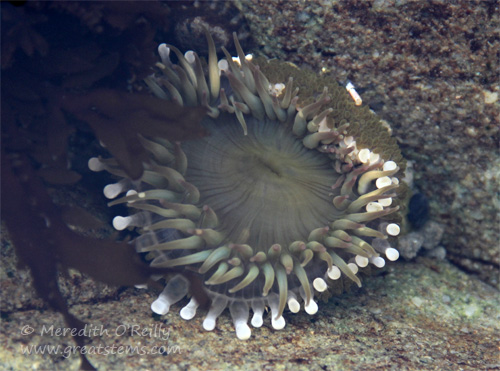 The sunburst anemone does not play nicely with others. Here is one displaying its acrorhagi, specialized stinging tentacles used when fighting with a competing anemone. I suspect the other anemone is hidden under that kelp.
The sunburst anemone does not play nicely with others. Here is one displaying its acrorhagi, specialized stinging tentacles used when fighting with a competing anemone. I suspect the other anemone is hidden under that kelp.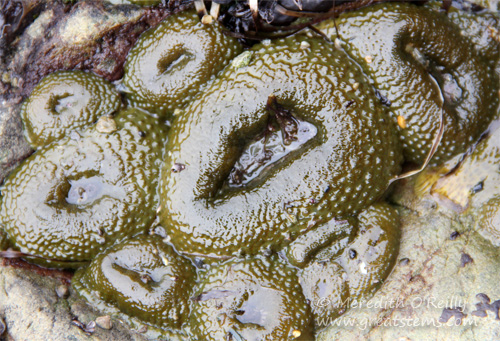 Sunburst anemones are very similar to aggregating anemones, Anthopleura elegantissima, so much so that they were once considered the same species until molecular study proved otherwise. “Aggregating” refers to the tendency of these particular anemones to form colonies. The anemones in the colonies are actually clones, genetically identical polyps formed asexually through fission. But like their solitary cousins, an aggregating colony is still territorial and will actually engage in a battle with any encroaching anemones that don’t have the same genetic makeup. That’s why the colonies are always seen spaced apart from each other.
Sunburst anemones are very similar to aggregating anemones, Anthopleura elegantissima, so much so that they were once considered the same species until molecular study proved otherwise. “Aggregating” refers to the tendency of these particular anemones to form colonies. The anemones in the colonies are actually clones, genetically identical polyps formed asexually through fission. But like their solitary cousins, an aggregating colony is still territorial and will actually engage in a battle with any encroaching anemones that don’t have the same genetic makeup. That’s why the colonies are always seen spaced apart from each other.
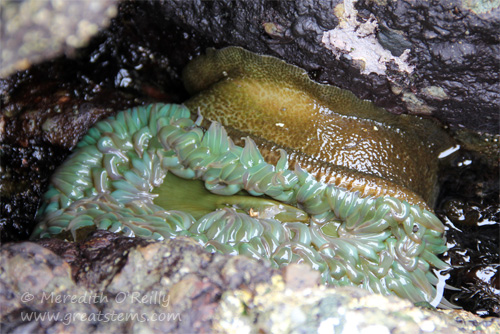 As the tide recedes, sea anemones expel water from their column, retract their tentacles, and fold inward in order to retain moisture within their body cavity.
As the tide recedes, sea anemones expel water from their column, retract their tentacles, and fold inward in order to retain moisture within their body cavity. 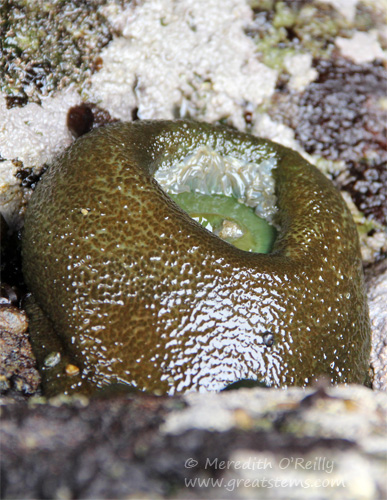 In addition to looking like an odd lump during this process, their size can be misleading.
In addition to looking like an odd lump during this process, their size can be misleading.
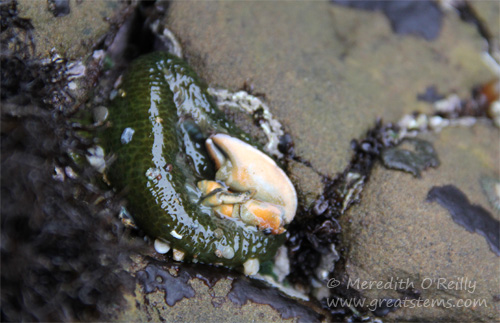 Here an anemone is still in the process of consuming a crab, despite being interrupted by low tide. It will expel any parts it can’t digest.
Here an anemone is still in the process of consuming a crab, despite being interrupted by low tide. It will expel any parts it can’t digest.
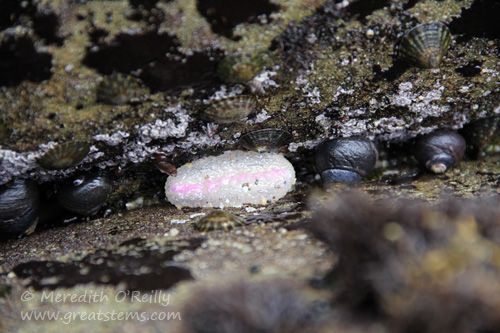
I happened upon this oddity among the rocks. My best guess is that it also is an anemone, but I would greatly appreciate someone sharing more information if they can. Some anemones, particularly if they are growing in an area with little sunlight, lack the special algae, zooxanthellae, that would typically grow in their endoderm. They thus appear white, but would they look like this when closed?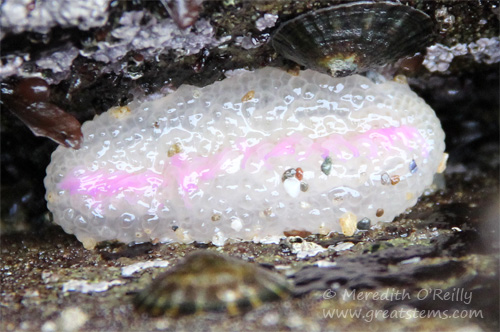
Take a closer look — see the pink tentacles? They make me think it is an anemone, like a sunburst or aggregating one, perhaps enclosed around something. But efforts to find similar photos online have failed, and the park rangers didn’t know the answer. By the way, note all the limpets nearby, and in the first photo, more Black Turban snails.
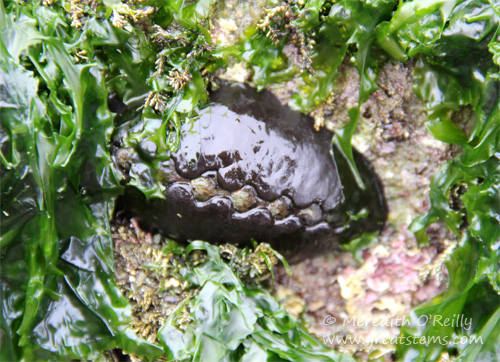 Black katy chitons, also called black leather chitons, are slow-moving grazers of algae and small barnacles, scraping them off with rasping, tongue-like appendages. They are effective at eroding rocks, as well.
Black katy chitons, also called black leather chitons, are slow-moving grazers of algae and small barnacles, scraping them off with rasping, tongue-like appendages. They are effective at eroding rocks, as well.
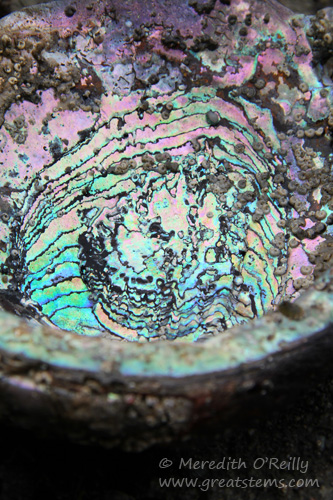
The iridescent interior of this abalone shell is no less beautiful for the barnacles that are growing on its surface.
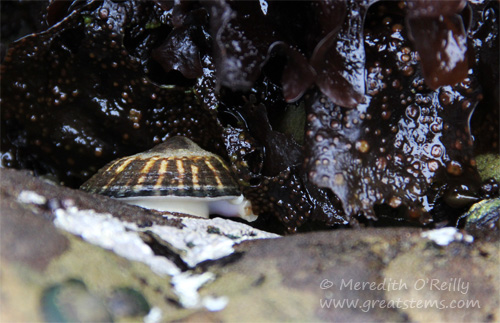 This limpet was actively moving about, and I felt quite lucky to get this picture at low tide. You can see its muscular foot, its mouth, and one of its tentacles.
This limpet was actively moving about, and I felt quite lucky to get this picture at low tide. You can see its muscular foot, its mouth, and one of its tentacles.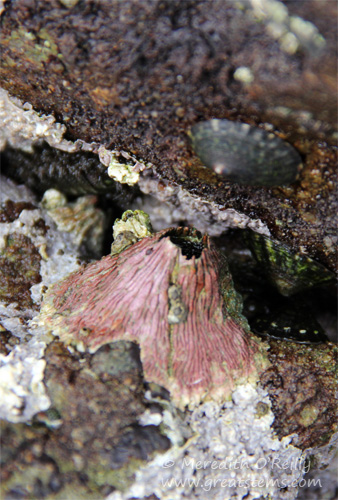 Lastly, this is a pink acorn barnacle (Tetraclita rubescens). Unlike the aggregating barnacles of the higher intertidal zones, the pink acorn is a solitary barnacle, typically living in the mid to low intertidal zones. Note that other barnacles are actually growing on it.
Lastly, this is a pink acorn barnacle (Tetraclita rubescens). Unlike the aggregating barnacles of the higher intertidal zones, the pink acorn is a solitary barnacle, typically living in the mid to low intertidal zones. Note that other barnacles are actually growing on it.
The water was a little too high for us to reach the low intertidal zone, although we saw a few of the same sea creatures that would have been visible there, including ochre sea stars, chitons, and the pink acorn barnacle. Sea urchins, sponges, and nudibranches, on the other hand, are seen when the water is at its lowest, which means you have to get farther out, as well. We weren’t keen on going out that far on those super-slick rocks at Gerstle Cove, so we stopped where we were.
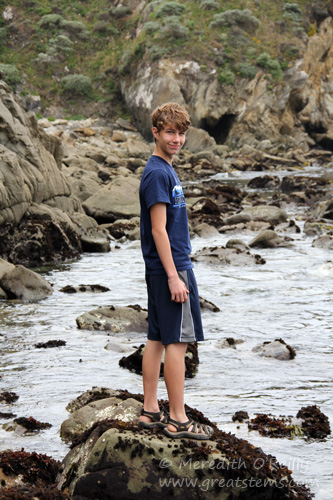
This view shows a bit of the tidal pool areas below the visitor center, along with my son. It’s easier to move among the rocks here, and the wildlife viewing is still great — if you have young children, we recommend that you visit these tide pools rather than the ones by Salt Point trail.

It was time to head north again, leaving the coast briefly to move inland and see more old-growth redwoods. We only had a few days left of travel, a bittersweet feeling.
Man – very cool location. I’ll have to add it to my list of things to see.
Katina, the Pacific coast has some of the best tide-pool viewing in the world. Get a times chart for your journey — then wherever you are on the coast, seek out the closest area you can visit at low tide. Many of the animals will be the same, and the biggest difference is likely how easy it is to view move among the rocks. Gerstle Cove was great, but it was definitely the most challenging place we visit in terms of tide pool access.
Fascinating place! You found a lot of great wildlife. It’s nifty how all the little creatures find crevices that are just the right size. Great post!
Thanks, PlantPostings! I learned so much visiting those tide pools — every creature has its own tale of survival adaptation. It isn’t easy being out there with the pounding waves!
Pingback: Pacific Journey: CA Coast to Redwoods to Oregon Coast | Great Stems
This is an amazing place! When I saw this I was immediately interested because of all these cool pictures. But I still have one question, in one of these pictures there is a picture of a boy standing on a rock, why is that picture there? Also, I think these pictures highly common to Westmister Woods.
These are good pictures of tha animals and we are going to Westminster Woods so I will know what to look for. Thanks Meredith!
Hi, Jay — I hope you had/will have a wonderful trip!
Re the “oddity” you guess may be an anemone, see my photo at http://intertidalsurvey.wordpress.com/ (the post titled Specimens posted to iNaturalist and Project Noah). The similarity with yours is the pink ring. My photo was taken deep under a rock edge where sunlight can’t reach the animal, which may explain the white instead of green color (was your specimen in the open?). This anemone, which may be an variation of the aggregating anemone Anthopleura elegantissima common in that area, may sometimes have pink tentacles and, when withdrawn inside the body cavity at low water, show only a pink ring at the base of the tentacles.
James, thanks so much for sharing. I’m glad that others have seen the same phenomenon. I should have posted to iNaturalist, too!